DENTAL RESTORATION

Restoration of teeth is a modern and efficient range of dental procedures able to return the teeth not only their basic functions but also to ensure a dazzling smile. This restoration is also called "aesthetic" or "art" as the ultimate goal is to achieve an attractive appearance.
The aesthetic restoration of teeth can solve the following problems:
• Uneven teeth
• Destruction of more than 50% of the tooth
• Gaps between teeth
• Darkening of the tooth enamel
• Caries in much of the tooth surface
Only functionally and anatomically correct restorations (fillings) will restore the function of the tooth.
Therefore, to restore the function of the tooth, it is necessary to recreate its natural structure. If the seal will have a flat surface it will crush food bolus during chewing, but a correct grinding and milling will not take place. In addition, in case of such a seal a chewing load falling on the tooth will be unevenly distributed: much of it will fall not on the restoration, but on the remaining "own" tooth tissue, which can lead to spalling of the "wall" of the tooth.
It is important to make the filling minimally noticeable: choose the color of the seal similar to the color of the tooth surface, polish the surface of fillings to achieve the same brightness as that of the tooth enamel.
In our clinic we try to choose materials offered by trusted manufacturers that have proven themselves in the market. We always try to provide our patients the right to choose the material that will be used during the restoration of the tooth. The light-curing composites ("light" fillings) correspond to these requirements.
The cost of good light-curing composites is quite high, and the efforts for achieving a functional and aesthetic restoration are considerable. For this reason, the quality fillings are usually expensive.
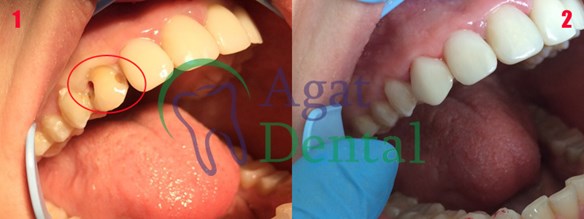
Examples of works performed in "Agat Dental" clinic You can see here.
Adhesive composite bridge constructions (light fillings)
The restoration experts of "Agate Dental" clinic offer a very interesting method for restoring the missing tooth: adhesive bridge constructions.
Advantages of this method are:
- minimum preparation of abutment teeth without removing the nerve of the tooth
- restoration of the missing tooth in one visit without laboratory stage
- restoration of the aesthetic and functional integrity of the dentition
- soft distribution of the chewing load due to the lack of a metal base
- prevention of atrophy of the jawbone
- low cost compared with metal bridges.
Examples of works performed in "Agat Dental" clinic You can see here.
Treatment of root canals of teeth (ENDODONTICS)
Endodontics is the branch of dentistry studying the methods and techniques of manipulation in the root canal, simply said, the removal of tooth nerve, cleaning and sealing of the roots of teeth. This is a complex and meticulous work that requires a doctor's professionalism and extensive experience. The success of treatment depends on the knowledge of the anatomical features of the teeth cavity of different groups, the availability and the ability to use high-technology endodontic tools, the knowledge of techniques of mechanical and antibiotic treatment and root canal filling. Our clinic is equipped with modern equipment and qualified personnel who meet these requirements. Proper tooth root canal treatment may require one or more visits and would save even heavily damaged teeth and prevent further complications that lead to tooth loss. Here you can cure even the wisdom teeth: we are trying to destroy the myth that they cannot be cured. The tooth that was well cured and restored through the endodontic method will serve for a long time.
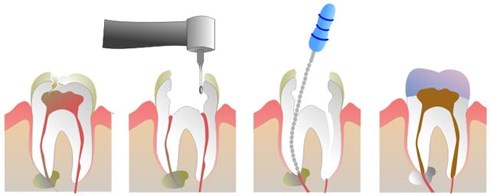
- instruments used in our clinic for measuring the length of the root canal and its treatment
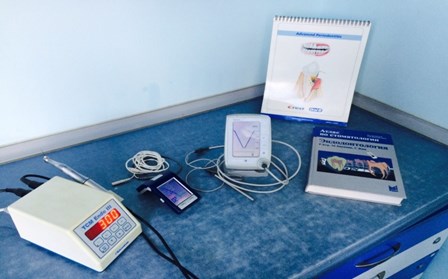
Professional teeth cleaning
What is a professional cleaning of teeth and why is it necessary?
Professional oral hygiene is a professional cleaning of the teeth in the dentist's cabinet. During this procedure all types of dental plaque are removed:
- dental calculus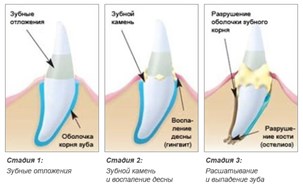
- soft dental plaque
- pigmented dense dental plaque
- "calculus of smokers", etc.
The teeth become clean, smooth and shiny.
Why is the dental plaque dangerous?
The dental calculus is located on the surface of the tooth at the gingival margin, as well as under the gum. They adversely affect the periodontal condition (i.e. all the tissues surrounding the tooth).
Similarly to dental plaque, the dental calculus is a cluster of microorganisms. Therefore, in addition to the fact that the dental calculus mechanically presses and injures the gums, the microbes of dental calculus cause inflammation of the gums, i.e. lead to the development of gingivitis.
If the supra-gingival dental calculus is not timely removed, the bacteria can penetrate under the gums, leading to the formation of periodontal pockets (spaces between the deep pathological tooth and gum), i.e. periodontitis shall develop.
Periodontitis leads to the loss of bone tissue, settling of gums and exposure of the roots of the teeth.
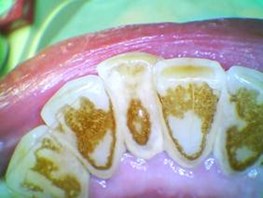

Before After
In addition, frequent signs of periodontal disease are bad smell of breath, loose teeth and accumulation of pus in the periodontal pockets.
Periodontitis is a serious disease. It can lead to loss of teeth due to loosening as a result of inflammation of the surrounding tissue. And the cause of this inflammation, as we have seen, are dental plaque and bacteria accumulation. In addition, wherever there is a plaque - there are microbes. And where microbes accumulate on the surface of the teeth - there develops caries over time! Therefore, regular professional oral hygiene is the best prevention of dental caries.
Comprehensive professional oral hygiene:
- removal of solid dental plaque ("calculus") via an ultrasonic scalar
- removal of dental plaque and tooth polishing through "AirFlow" method
- teeth fluoridation
In our clinic, oral hygiene is performed only by specialists with higher medical education, not hygienists (who are nurses). Comprehensive dental cleaning is recommended for all people 1 time in 6 months. This procedure helps prevent tooth caries and gum diseases.
WHITENING
Each day our teeth are exposed to a variety of products containing various dyes. As a result, they turn yellow, lose their lustre, and our smile is no longer a subject of admiration and pride. The optimal solution to this problem is the teeth whitening. Our doctors the well-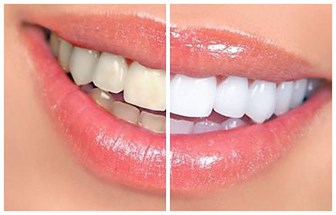 known technology of the company "Ultradent". It allows to perform whitening in just an hour without any discomfort to the patient. Teeth after the procedure appear to be more healthy and shiny. The basis of this system is an acid-free gel which is released under the influence of active oxygen effectively penetrating the deepest layers of the tooth enamel and successfully eliminating the strong and lasting pigmentation. The "Ultradent technology does not cause any damage to tooth enamel as well as to general health of the patients. Moreover, high-performance processing of enamel with fluoride after the whitening procedure guarantees reliable strengthening of teeth.
known technology of the company "Ultradent". It allows to perform whitening in just an hour without any discomfort to the patient. Teeth after the procedure appear to be more healthy and shiny. The basis of this system is an acid-free gel which is released under the influence of active oxygen effectively penetrating the deepest layers of the tooth enamel and successfully eliminating the strong and lasting pigmentation. The "Ultradent technology does not cause any damage to tooth enamel as well as to general health of the patients. Moreover, high-performance processing of enamel with fluoride after the whitening procedure guarantees reliable strengthening of teeth.
An important advantage of the technology used by the clinic is its long-term effect (1 to 3 years), depending on the patient's compliance with the recommendations provided by the doctor.
Before performing this procedure, the patient should:
- Undergo hygienic cleaning of teeth and oral cavity;
- Clean tartar and plaque;
- Cure the existing carious formations;
- Undergo comprehensive sanitation of oral cavity.
Within five days after the teeth whitening the patient should refrain from eating food with colorants (chocolate, coffee), smoking, and the use of toothpastes that have abrasive particles.

before after
Professional whitening is divided into two main groups: cabinet whitening and home whitening under the doctor's supervision.
Home whitening is more cumbersome for the patient and requires daily procedures at home. Every day the patient needs to put on a special mouth guard for teeth with whitening gel placed inside and keep it for a few hours during the day or at night put. The duration of whitening teeth at home is 2-4 weeks (depending on the initial state of teeth, on the desired effect and on the chosen bleaching system).

before after
Certificates for professional whitening You can watch in Gallery page.
PERIODONTICS
There is a saying: "periodontal disease is a silent killer of teeth." Sooner or later, these problems may lead to the loss of the tooth.
Special danger lies in the fact that often the onset of the disease may be asymptomatic, i.e., imperceptible to humans. Symptoms such as
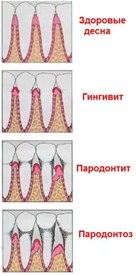 the presence of dental plaque, bleeding gums when brushing your teeth or bad breath are often perceived by patients as minor and not worth the attention.
the presence of dental plaque, bleeding gums when brushing your teeth or bad breath are often perceived by patients as minor and not worth the attention.
The reasons for such diseases are sometimes obvious and sometimes it is virtually impossible to ascertain. All causes can be divided into local and general. Local adverse factors are directly in the mouth (poor hygiene, plenty of dental plaque, poorly supplied seals and orthopedic structures, external mechanical stimuli, etc.). Common causes are a variety of diseases of the internal organs and systems (endocrine diseases, diseases of the gastrointestinal tract, blood disorders, immune system failure, etc.).
Methods of treatment of periodontal disease are divided into conservative (therapeutic) and surgical. The choice of treatment depends on the disease, its stage, and existing morbidities. Sometimes regular therapeutic procedures can be sufficient, and in some cases cannot evade the surgical intervention.
Gingivitis is the inflammation of the gums, in case of which there are no periodontal pockets yet.
Symptoms of acute gingivitis are swelling, redness, soreness of the gums, bleeding while eating and brushing teeth. Sometimes sores may appear on the gums.

Periodontitis is an inflammation of the gums, passing from the mucous to all the tissues and the surrounding and locking teeth in the jawbone. The result is a destruction of the periodontal compound and reduction of the volume of bone tissue around teeth, which can lead to loosening and loss of the teeth.
In case of the lack of adequate treatment the depth of periodontal pockets increases, there is an atrophy of the bone tissue and an exposure of the roots of the teeth. When roots of the teeth are exposed, hypersensitivity to changes in temperature and chemical stimuli may occur.
Periodontal disease in case of a periodontitis there is usually no bleeding and inflammation of the gums, periodontal pockets are not formed, there is no loosening of the teeth, and bad breath is minimal or absent. Most often the main cause of periodontal disease is the atrophy of alveolar processes (bone tissue of the jaw), which leads to a uniform "lowering" of the gums and to exposure of the roots of the teeth (with the absence of their mobility).
A comprehensive treatment of periodontal disease is required, affecting all vital systems of the body. It is recommended to perform not only local, but also restorative treatments (herbal medicine, vitamin therapy, laser therapy, etc.). Well, of course, the treatment of advanced periodontal disease is not without surgical methods.
The treatment of periodontal disease depends on the cause and degree of the disease.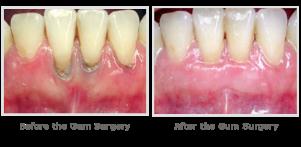
First it is worth identifying and eliminating the possible causes of the disease (treat the underlying disease, replace incompetent fillings and crowns).
This is followed by a mandatory professional oral hygiene, removal of soft and hard dental deposits, only after which a local and general treatment can be assigned.
In case of gingivitis or mild periodontitis (when periodontal pockets are not very deep) the dental plaque is removed through the application of the usual method (using ultrasound, as well as hand tools according to the type of scrapers).
If the depth of periodontal pockets is 4-6 mm, then we are talking about moderate periodontitis. In this case, it is not possible to reach the dental plaque located at the bottom of the pockets using conventional tools. To remove the dental plaque and tartar, it is necessary to make small incisions in the gums to bend the edge and clean all periodontal pockets.
In case if the degree of periodontitis is severe and the pockets are deeper than 6 mm, the height of bone is decreased by more than 1 \ 2 of the length of roots, and there is considerable mobility of the teeth, the need for surgery arises. The operation, which is used to clear deep periodontal pockets from the dental plaque and reduce the depth of the pockets is called flap surgery. "Agate Dental" clinic is one of the few clinics in Yerevan that offers a large spectrum of periodontal operations which are performed by a periodontist with high qualifications trained in the New York Medical University. The clinic periodically organizes consultations with a clinic professor of the surgical sciences New York University, New York director of periodontal residency V.A. Medical center Dr. Gregory Krikor Kazandjian.
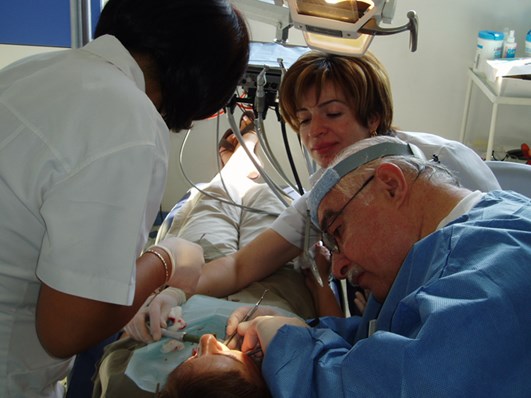
Flap surgery (to reduce the periodontal pockets)
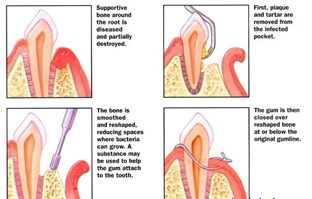 In case of this procedure, the doctor receives immediate access to periodontal pockets and tooth roots. Flap surgery is performed under local anaesthesia.
In case of this procedure, the doctor receives immediate access to periodontal pockets and tooth roots. Flap surgery is performed under local anaesthesia.
The operation consists of carrying out several sections in the gums, thereby forming a flap. This flap is lifted, providing access to the root of the tooth. This allows the doctor to "clean up" the root from tartar, polish it, remove all the abnormal tissue in the periodontal pocket. If necessary, the bone tissue is replaced with grafts to increase the size of the alveolar bone. For better regeneration of the bone tissue, sometimes special gels and membranes are used that are laid under the flap. After the necessary manipulations doctor sutures the gum flap back.
Postoperative period usually lasts several days. Follow all your doctor's instructions. Usually the doctor makes the following recommendations:
- If necessary, take painkillers;
- To reduce the swelling and pain in the surgical wound gently rinse your mouth with a weak solution of salt and soda, as well as special antiseptics;
- Avoid strenuous exercise to prevent bleeding;
- In the beginning eat only soft food;
- Carefully brush your teeth;
- You can put a chill on the cheek in the area of operation (such as an ice pack);
- Limit smoking.
The stitches are removed by a doctor in a few days, or dissolve themselves.
Bone grafting
Bone grafting is used when a decline in bone tissue as a result of periodontal disease is significant and it is necessary to restore the bone volume. This surgery is usually combined with flap surgery. A bone graft is placed under the flap. These can be either artificial bone or bone tissue taken from the patient from another area of the jaw. After suturing the flap, there is a gradual engraftment of the implant and increase of the bone tissue in the tooth.
Plastic of lip and cheek bridles
Just as in the case of oral vestibule fine, the short lip or cheek bridles lead to a constant tension of the oral mucosa. This thrust causes gingival recession and exposure of the necks of the teeth. To get rid of this tension, it is necessary to perform the plastic of bridles. Calibration is performed surgically using multiple sections, followed by suturing. The procedure is performed under local anaesthesia and is quite easily tolerated by patients. The healing period is only 3-7 days.
Plastic of vestibule (increasing the depth of the vestibule of the mouth)
Often, the cause of gum disease is a congenital small vestibule of the oral cavity. This means that the transition of the mucous of gums to lip or cheek (so-called transitional fold) is very close to the gingival margin and to the necks of the teeth. When moving of the lips and cheeks, mucous is constantly in tension. Over time, because of this thrust the gum rises thus exposing the neck and roots of the teeth. To reduce this chronic tension, it is necessary to make special cuts in the transitional fold. After healing of cuts, transitional fold moves away from the edge of the gums and mucous tension weakens.

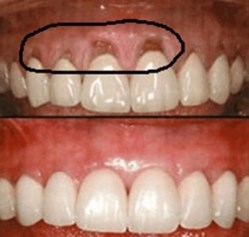
Medicine treatment is chosen individually. Doctor can assign both local procedures and general treatment.
Local procedures: embrocating and application of drugs; applying to the gums specialty films, gels and ointments; rinsing the mouth with different solutions; massage of the gums; physiotherapy; regular use of special toothpaste, etc.
General treatment: intake of antibiotics, vitamins, medicine to improve blood circulation and immunity, antioxidants, dietary supplements, homeopathic remedies, etc.
Also, given that one of the most unpleasant symptoms of periodontal disease is the abnormal mobility (loosening) of teeth, it often requires the use of a method of splinting (i.e. the union of teeth into a single unit, they are bound to each other). As a result, each tooth itself becomes less mobile, as it "hold" the adjacent teeth.
ORTHOPEDICS
1.Vineers
Veneers are micro prostheses with which the front surface of the teeth belonging to the smile line are faced. Veneers allow reconstructing the shape and color of a single tooth or group of teeth, but unlike bits - they do not cover the whole tooth, but only one or two of its surfaces.
Advantages
- The speed, in case of composite veneers only one visit.
- Durability, especially in case of ceramic veneers.
- Excellent cosmetics due to the lack of metal and other opaque materials.
- Modern ceramics is transparent - it transmits light so that the teeth look natural.

2. Lumineers
Lumineers are ceramic plates on the teeth, similar to veneers, but thinner. Lumineers require little or no grinding of teeth. At the same time the lumineers are as strong as the classic veneers.
The main purpose of lumineers is the ability to hide the defects of the existing dentition and give the patient a dazzling white-toothed smile.
The main advantages of lumineers
- requires little or no grinding of the teeth;
- speed of installation (lumineers are installed within two or three visits to the dentist);
- almost no anaesthesia is required;
- do not need temporary structures;
- do not change colour in contrast to the composite restorations and fillings;
- harmless to teeth;
- reducing exposure to dental caries;
- fluoridation of tooth enamel due to the high content of fluorine in the composition of cement, with which lumineers are attached.

3. Crown
Crown is a single fixed prosthesis that replaces the visible part of the tooth. This type of prosthesis is produced exclusively on an individual cast-sample and repeats the shape of the natural tooth, its colour and other features. Quality crown is completely invisible and completely hides the flaws, chipped teeth and other shortcomings. Furthermore, the crown can be used as a basis for fixing other designs aimed at restoring the integrity of the jaw. In this case, other than restoring masticator function and the aesthetic, it also acts as a foundation for attaching other structures.
Advantages of dental crowns:
- Aesthetics.
- Durability and strength depends on the material and method of manufacture of the crown.
- Affordability.
- Cast crowns do not require strong grinding of teeth.
- The white ceramic crowns on the teeth are ideal for front teeth prosthetics.
- Dental crowns are biocompatible with the tissues of the teeth and gums.
- Installing a crown on a dead tooth extends its functionality.
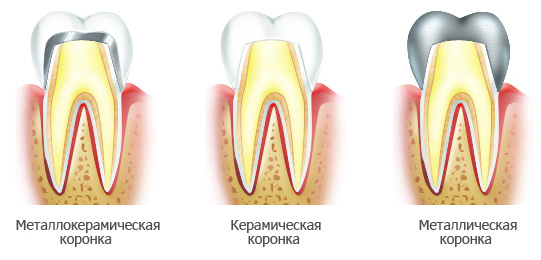

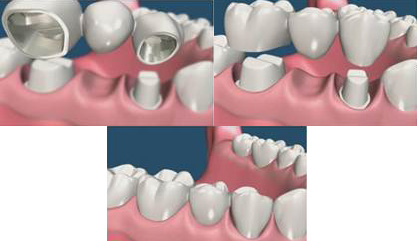
4. Prosthesis on implants
Prosthetic implants is that the artificial teeth are fixed to implanted into the bone tissue and titanium pins (implants). Surgical implantation phase lasts an average of 3-5 months (during which there is a "fusion" of the surface of the implant and the bone). Then you can start the prosthetics. Prosthetics on implants can be removable and non-removable.
Non-removable prosthetics on implants
Typically, non-removable prosthetics on implants is used in case of a patient with small defects of dentition, i.e. when missing one or several teeth.

Removable prosthesis on implants
Removable prosthesis on implants is usually performed in the absence of teeth, or in case if there are only a little number of teeth maintained.
Under this option, the connection of the prosthesis with prosthetic implant is performed with a principle of a micro lock: half of the micro lock is installed in the prosthesis, the other half is installed in the part of the implant that protrudes above the surface of the oral mucosa. When putting on the prosthesis the micro lock snaps and secures the prosthesis in the oral cavity.

5. Removable prosthetics
Partially removable - this type of prosthesis is used in case of a single loss, or loss of teeth, standing nearby, as well as for minor defects of the dentition. There may also be a temporary solution until a choosing or manufacturing a permanent structure, they do not require constant taking off and are almost not felt and do not bother the patient.
Fully removable prosthesis are used when there is a complete loss of teeth and jaw is replaced entirely.



Bow prosthesis
This is one of the varieties of prosthesis. Its name comes from the word «bügel», which means "bow". Unlike many of the similar structures made of plastic, at the heart of the traditional bow prosthesis is cast metal frame, on which the acrylic base is applied and the artificial teeth put. The durable basis of the bow eliminates the need for technician to create a strong plastic layer, that is why the size of the structure becomes smaller and the prosthesis are comfortable to wear.
Benefits:
- Size of the bow prosthesis (its thickness and volume) is significantly smaller than that of the plastic prosthesis.
- When installed on the upper jaw in the area of the front teeth it is just a thin arc of metal rather than plastic bulk jumper, which prevents to taste and talk clearly.
- In the case of the lower jaw prosthesis, using bow prosthesis allows more space for normal movement of the tongue, which is important for diction and chewing food.
- The lifetime of bow prosthesis is up to five years, and it is two times more than in case of other prosthesis.
- The bone and gum tissue in the parts where it touches the prosthesis is less atrophied. Atrophy of tissues leads to deterioration of the fixation and the appearance of pain or discomfort.
Bow prosthesis is highly durable because it is based on a cast metal frame, on which the acrylic base is welded with well anchored artificial teeth.
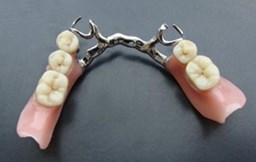
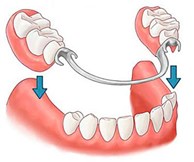
SURGERY
Resection of the apex of the root is a surgical procedure that allows painlessly eliminate all manifestations of chronic periodontitis. This procedure is carried out for about 30 to 60 minutes and is comprised of removing of cysts situated in the apex of the tooth root. Simultaneously with a cyst part of the root is also removed. Initially, the dentist makes a small incision in the gum. Then, in the bone tissue an opening is made through which the removal apex of the root with a cyst formed thereon is performed. Root apex resection is performed under local anaesthesia, using a drill.

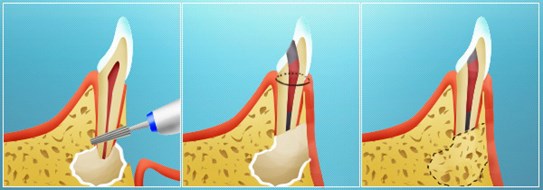

Cysts
Symptoms of cyst of the tooth
The cyst is the increase in size of a tooth granuloma (bigger than 0.5 cm in diameter). The development of such tumors deep in the bone, in most cases, happens without any symptoms during several years. Therefore, the detection of cysts occurs either accidentally on x-ray, or when the cyst has already broken and released its contents into the bone.
Reasons for the formulation of cysts
The appearance at the apex of the tooth of a sac filled with abnormal fluid can be caused by several reasons:
- untreated caries complications - pulpitis or periodontitis;
- tooth injury, particularly root fracture;
- poor quality treatment of root canal.
Methods of treatment of cysts
In the early stages of formation the cysts can be treated through therapeutic treatment, in particular the introduction of copper ions into the top of the tooth. If conservative treatment does not have the desired effect, then a surgical intervention shall be undertaken through one of the following types of operation: cystotomy, cystectomy or resection of the root apex.
Cystectomy - a radical operation during which the cyst and its shell are completely removed and the wound is tightly sutured.
Cystotomy - a method of surgical treatment of cysts, in which the front wall of the cyst is removed. This operation is less traumatic, easier tolerated, but has a longer postsurgical period.
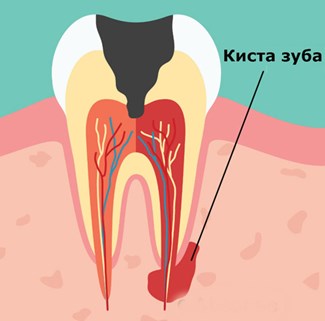

Periostitis of the jaw - inflammation process the center of which is in the periosteum.
Periostitis of the jaw - is an emerging inflammatory process as a result of a number of diseases of the teeth with the center of the of inflammation in the periosteum. In household the periostitis is still often referred to with its original traditional name - flux.
The causes of periostitis of the jaw
- Teeth with problems are the most common source of infection of the jaws.
- Not timely cured inflammatory diseases of the teeth may lead to the progression of infection towards the jaw.
- It is much less common that the pathogens penetrate into the jaw from wounds, such as open fractures of the jaw or large infected wounds of the soft tissues of the face.
- More rarely, the infection penetrates into the jaw through the blood or lymphatic vessels from other foci of inflammation, such as tonsillitis, and various infectious diseases that primarily occur with children.
In most cases, periostitis of the jaw occurs as a complication of periodontitis, or as a complication after tooth extraction, particularly when preceded by hypothermia, influenza, angina, and other diseases.
The treatment of periostitis in the dental clinic is often performed through surgical intervention.
After local anesthesia the abscess is opened, and for better drainage of pus a special rubber drainage (ribbon) is placed in the wound for 2-3 days.

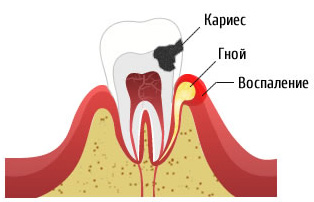
Pericoronitis is the inflammation of the gum tissue around the erupting teeth. Usually pericoronitis strikes gingival tissue around the wisdom teeth of the lower jaw.
What is the reason that the person may experience shortness of teething, especially wisdom teeth?
There can be several reasons. Here are the most common ones:
- incorrect position of wisdom teeth (it grows "sideways", resting on the chewing surface of the adjacent teeth);
- incorrect position of the root of the tooth;
- thickening of the wall of the dental sac (it surrounds the tooth crown);
- thickening of the mucous membrane of the gums so that it becomes hard for the tooth to "get through."
The surgical treatment of pericoronitis is conducted as follows. The doctor incises the infected part of the gum hood. Then the doctor carefully removes the pus, and then washes the incision with antiseptic. Naturally, all surgical procedures are performed under local anesthesia.
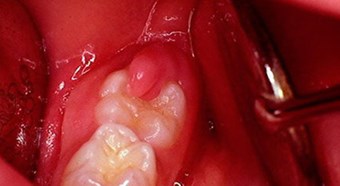 |
 |
 |
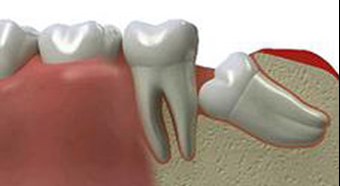 |
 |
 |
Bridle
In most cases, the gap between the front teeth arises as a consequence of a short frenulum of the upper lip. Before installing the brackets it is required to remove this obstacle to rapprochement of the teeth. Frenulum of the upper lip is a film or a fold of mucous membrane, which is formed at the transition into the gum lip. If the frenulum of the upper lip is short or it is too dense and closely attached to the teeth, the patient may experience the following cosmetic and functional defects:
- Gap between the front teeth (diastema)
- Inexpressive smile due to inability to completely push the lips. Defects of speech or pronunciation of individual sounds.
- Moving after the lip the frenulum pulls the inter-dental papilla. In case of older people, it leads to constant irritation, gum recession and exposure of the necks of the teeth. In case of children in the mixed dentition this defect can lead to the movement of the front teeth forward.
For the doctor who knows the modern methods of treatment, to remove the gap between the front teeth does not pose any difficulties: it is necessary to eliminate the cause - a short frenulum of the upper lip (if that is the cause of the diastema) and its consequence - the gap between the teeth.
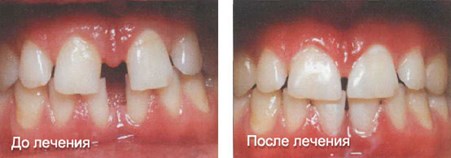

DENTAL IMPLANTS
Implantology in dentistry is specialized in the restoration of the lost functions of individual teeth or groups of teeth. We can say that this is a special type of non-removable prosthesis. Implantation is an alternative to removable dentures. And if in some cases the use of a removable denture is impossible or extremely difficult for aesthetic, professional, or other indications, the solution for such situation can be the dental implantation.
In case of a dental implant a metal, plastic or ceramic implant is implanted in the jaw (implant) special design (the implant) which is used as a support for a dental prosthesis. Currently, there are a large number of dental implants, each of which has its advantages and disadvantages.
The implantation of dental implants is carried out in three stages. At the first stage the implant is implanted in the jaw surgically. After a period of healing an abutment is attached to the screw-implant which serves as a link between the artificial tooth and the implant. This is the second phase of the operation. Then a process "splicing" of the implant and the bone happens, so that the implant becomes part of the jaw. The third stage assumes preparation of a tooth denture and its attachment to the implant system. As a result of this operation, new teeth feel and look like natural.
The absolute contraindications to dental implants include:
- diseases of the blood and blood-forming organs. For example, a bleeding disorder makes any transaction impossible due to the development of serious bleeding.
- diseases of the central nervous system (both congenital and acquired). The most striking example is a mental illness in which the patient cannot adequately perceive the information on the rules of conduct during and after treatment.
- malignant neoplasm of various organs and systems (cancer, sarcoma). Surgical intervention can affect tumour growth and metastasis.
- immune-pathological conditions (surgery necessarily require some active and quite hard work of the immune system to normalise tissue healing after surgery)
- systemic diseases of connective tissue. Implantation is very demanding on the growth and development of connective tissue around the implant, so diseases such as systemic lupus erythematosus, scleroderma, rheumatoid, rheumatoid, and other diseases make the implantation process impossible.
- tuberculosis and its complications
- some diseases of the oral mucosa: chronic recurrent aphthous stomatitis, systemic lupus erythematosus, pemphigus, Sjogren's syndrome, and others.
- diabetes mellitus type I
- hyper tonus of masticator muscles, bruxism.
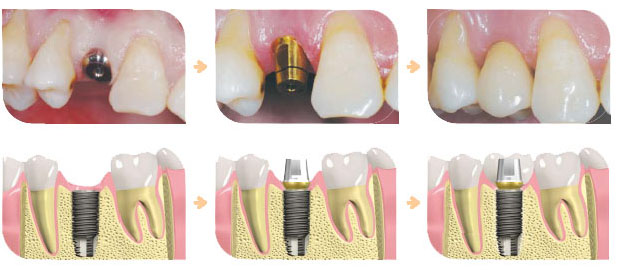

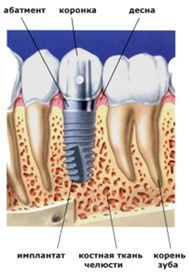
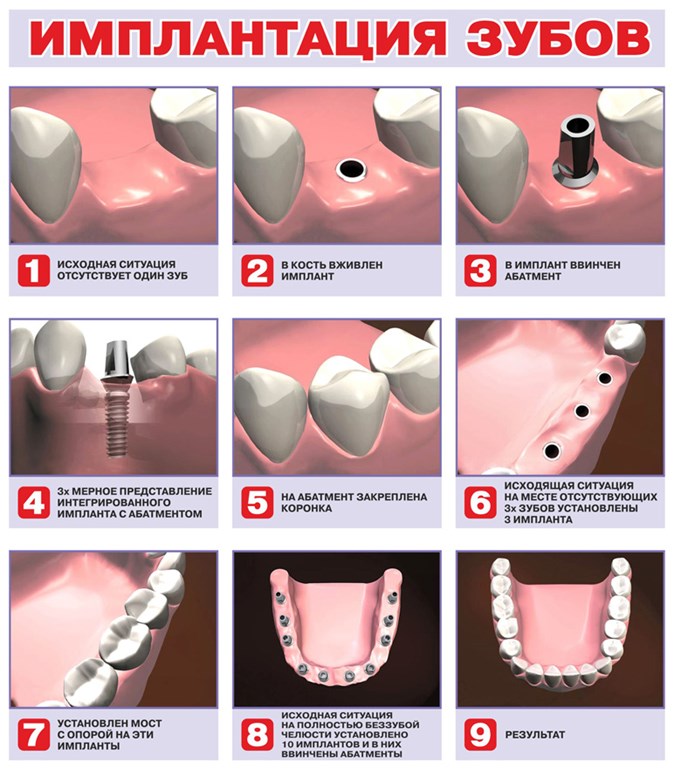
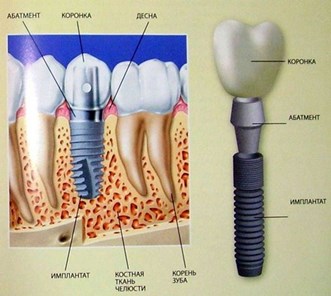

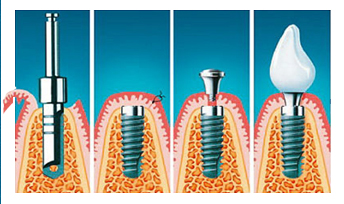
Orthodontics or orthodontia implies correction of different malocclusion and alignment of teeth positions. Malocclusion are not only cosmetic deviations, but cause of other problems, like difficult breath, speech defects, overcrowding of teeth – complication for hygiene, and reason of multiple caries, gum diseases, incorrect chew – condition for temporo-mandibular joints, dental abrasion, even for disturbances of gastrointestinal tract. Thereby, purpose of orthodontic treatment not only beautiful smile, but prophylaxis of many diseases. Therefore, would be better to consult with orthodontist in time for reach result as easy as possible.
It’s important to mark, that contemporary orthodontia allows correction of malocclusion in any age. Significant is condition of teeth and bone tissue. Principal – there is no age restriction. Detailed consultation could help to choose treatment plan.
Orthodontic treatment realizes by removable or fixed methods. Removable method uses devices – appliances of different configuration. Removable appliances are substantially more comfortable because of:
- Removable – means not fixed, so you can easy take it off, clean your teeth and appliance, and take it on. So hygiene is most simplified. Appliances are individual made and well retain on teeth.
- Due to different configuration of appliances this method allows in many disputable cases to correct malocclusion without teeth extraction.
- Sometimes, during any important business meeting, examination, etc., you can take your appliances off. This fact considerably more comfortable for patient during orthodontic treatment (but it isn't possible during fixed method).
Individual approach and detailed consultations give an opportunity to make irreversible decision. Orthodontic treatment demand patience, but in the end of the treatment you’ll be well-deserved rewarded. Aim of treatment not only to reach a result, but to retain it, so necessary to follow recommendations of orthodontist.
Examples of works performed in "Agat Dental" clinic You can see here.
Children's Dentistry
Every child who comes to our clinic can get a full range of dental services. We use innovative, effective and safe methods of treatment envisaged for children. Our experts know how to approach even the most capricious and restless baby! We will help young patients to get rid of the fear of doctors and dental clinics and will carry out any procedure of teeth treatment completely without any pain. And after the end of treatment every kid will necessarily receive a nice gift!


Use in aesthetic medicine
Plasmolifting™ technology is widely used for aesthetic and cosmetic purposes, as it is shown to be a very effective anti-aging tool that switches the body functions into a “youth mode”.
Indications for use:
- Age-related skin changes (chronoageing)
- Aging of the skin caused by UVA and UVB exposure (photoageing)
- Acne lesions and scars
- Sensitive, stressed skin
- Skin diseases (atopic dermatitis, psoriasis, eczema)
- Cellulite
Plasmolifting™ technology, when used in aesthetic medicine, helps:
- Improve overall skin appearance and texture
- Improve skin tightness and elasticity
- Reduce fine lines and wrinkles
- Reduce skin hyperpigmentation
- Reactivate natural synthesis of hyaluronic acid and collagen
- Reduce signs of photo- and chronoaging
Skin rejuvenation can be achieved after the first course of injections and lasts for up to two years.
Plasmolifting™ Gel Therapy
Gel therapy is a minimally invasive, non-traumatic and effective injection procedure used to reverse the signs of ageing and restore a more youthful appearance. It involves preparation of autologous plasma gel and its injection to the patient in order to reduce deep wrinkles and facial imperfections, as well as to restore youthful facial contours.
How is this procedure performed?
Autologous gel is prepared from autologous human plasma obtained with the use of our specialized vacuum tubes. Obtained autologous plasma is undergoing heat treatment in a block heater whereby it thickens and turns into a gel. The gel is injected into the skin for wrinkles filling. It is distributed homogeneously in the tissues, not leaving any visible marks of the performed correction. This gel activates the connective tissue cells, thus forming a “support structure” of the face; in addition, it stimulates tissue regeneration processes, ensuring a long-lasting effect of the procedure.
Indications:
- Age-related atrophic changes in the skin (wrinkles, lines, elastic creases)
- Skin laxity
- Mid-face volume loss
- Acne scars
- Ptosis and facial contours changes
This procedure may be used to:
- Fill and efface facial rhytides (nasolabial folds, perioral and forehead rhytides, wrinkles around eyes, melomental folds, nasojugal groove)
- Correct facial contours
- Restore mid-face volume
- Smoothen skin texture in patient with acne or atrophic scars
- Form a facial “support structure” of new connective tissue, thus preventing wrinkles
- Stimulate skin regeneration and rejuvenation
Use in dentistry
In dentistry, Plasmolifting™ technology is successfully used for stimulation of regenerative processes in tissues. Autologous plasma is locally injected in damaged gingival tissues, desired implant sites, extraction sockets, and soft tissues in maxillofacial area to treat acute and chronic infection-mediated inflammatory processes. Growth factors contained in autologous plasma promote capillary budding, optimize the hemodynamic status, regulate cellular respiration and metabolism, and increase tissue immunity.
Indications for use:
- Generalized periodontitis
- Gingivitis
- Localized periodontitis
- Alveolar osteitis
- Dental implant placement, dental extraction
- Peri-implantitis
- Periodontal disease preventing
Plasmolifting™ technology, when used in dentistry, helps:
- Control gum bleeding
- Prevent and treat periodontal diseases
- Make the teeth less mobile
- Manage pain
- Treat bad breath (halitosis)
- Promote healing of extraction sockets
- Increase implant clinical survival rate
- Accelerate osseointegration of dental implant
- Compensate for the missing bone volume
- Shorten the recovery period after maxillofacial surgery




